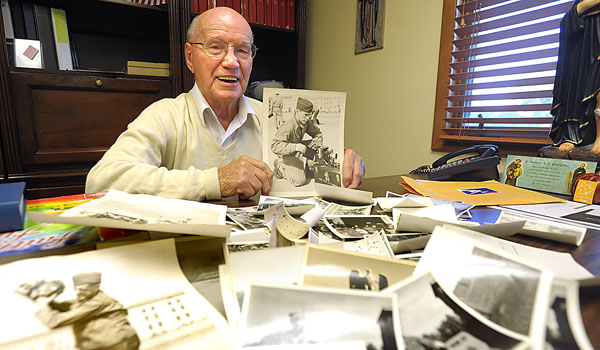World War II veteran recalls experiences in Army Air Forces
by KIMBERLEE SABSHIN
Each year on Veterans Day, the United States honors its men and women who have served in the Armed Forces. Richard Jeffers, 93, a parishioner at St. Martin of Tours in South Buffalo, is one of the approximately 16 million Americans who served their country in World War II. He served in the Army Air Forces as a photographer from 1944-45.
See photographs from Jeffers' time in World War II.
Jeffers was working for the Columbus McKinnon Corporation in Tonawanda, manufacturing chains and other supplies for industrial work at the time he was drafted.
Jeffers lived his entire life in South Buffalo or West Seneca aside from his time serving in Europe. His brothers also served in branches of the U.S. military. Jeffers recalled how the Battle of the Bulge began shortly before Christmas of 1944 and the war ended in Europe and the Pacific the following year.
"First, we all went through an examination," Jeffers said. "They told you what was wrong with you, but they took you anyway for the most part. We were a headquarters of a service group. They were the ones that took care of all of the things that were needed to operate as a fighter group."
Photographers were needed if any public relations were required or for specific situations such as a plane crash. Military photographers had to go out and take pictures of the crash for official recordkeeping. "I did all of my fighting with a camera," Jeffers recalled.
"Whenever there was a plane crash, we got a call to send someone with a camera to wherever that was," he added. "It was more or less in the southern England area. We had to take pictures of maps that were used where the fighter group was assisting the bombers. That was our main job."
After being drafted in 1943, most of his activity was based in southern England while the Allied forces prepared for the invasion of the German troops. Before this, he started out at Fort Niagara and had gone to basic training in Miami Beach, Fla. He then went to photographic school in Denver.
"From there, I was put in the 437th Troop Carrier Group," Jeffers said. "I was one of the members of the photographic section. There were eight of us. We all started as privates, and our ranks started from there. We were shipped back to Florida. We got together at Myrtle Beach, S.C. The service group was formed at that point, and we were shipped by the Queen Mary over to southern England."
By the time Jeffers arrived in England, the Allies were preparing for the German invasion. Jeffers was a sergeant and was put in charge in the photographic section. They serviced a fighter group and when the invasion started a month later, they followed, landing in Omaha Beach in German-occupied France.
"We followed the troops all the way up into Belgium, and that's where we joined up with the group that was there," Jeffers said. "While we were there, the Battle of the Bulge started. At the time, we were living in a hotel in Dinant, Belgium. The reason for the hotel was because on the grounds wherever anybody had their tents, there was about six inches of mud that you had to plow through."
Members of the photographic section stayed on the top floor of the hotel until the Battle of the Bulge, the largest battle the United States troops fought in World War II, started on Dec. 16, 1944. Once the fighting got serious, they were shipped from the hotel and put into what Jeffers called a "castle," where they stayed until the end of the battle. After the battle, members of the photographic section were put into stations at an air base in the middle of Germany.
"From there, we were at the end of the war," Jeffers said. "We were shipped directly into Berlin for duty after the war was over."
Jeffers said that whenever it was possible to attend Mass, a good percentage of the men in his group would go.
"We had Masses on the front ends of jeeps," Jeffers said. "We had them in bombed-out churches, anything, wherever we could meet and operate."
Jeffers stayed in Germany for several months before being shipped to England where he was put back on the Queen Mary and sent home. After returning home, Jeffers married and started a family. He and his wife had five girls and two boys.
Jeffers did not seek out veteran's organizations due to his commitment to his family and home life, but the military stayed part of his family's life. Of his twin boys, one served in the Coast Guard assisting in Italy, while the other served in the Air Force in Alaska. Jeffers and his family have been parishioners at St. Martin of Tours for 66 years.




